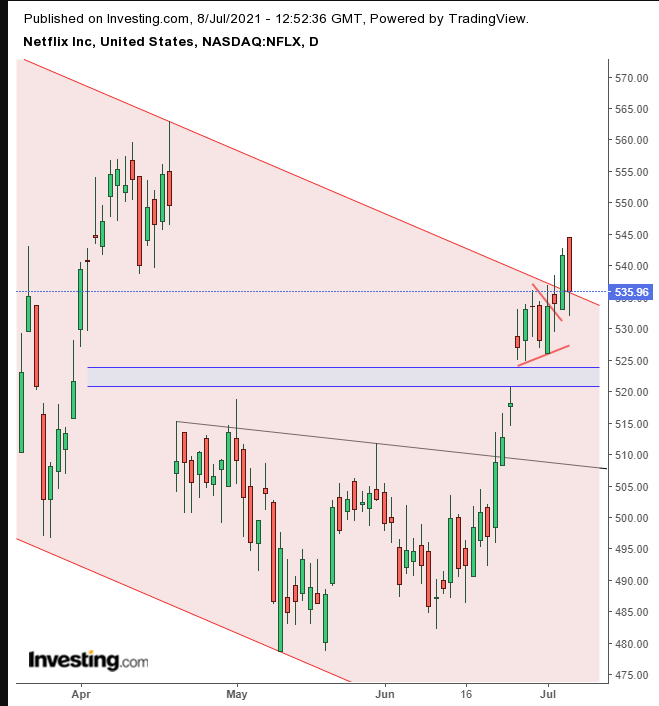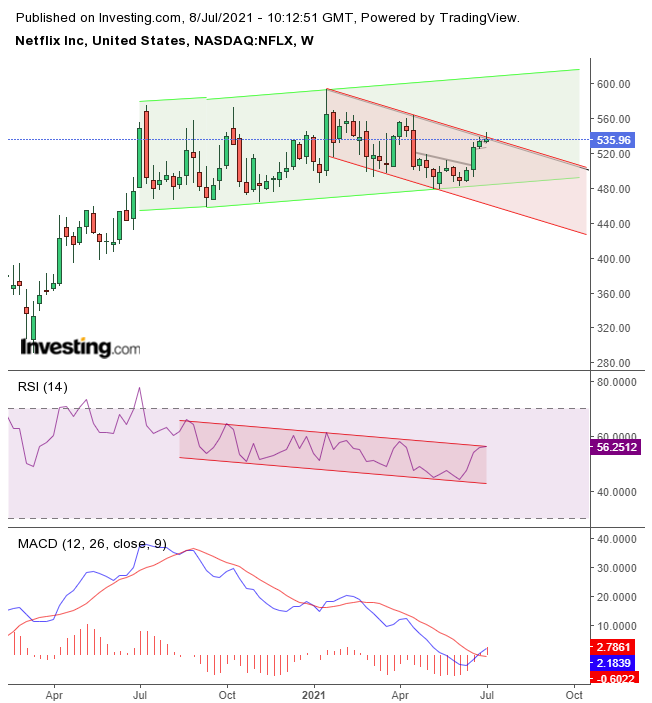Netflix (NASDAQ:NFLX) is up 12% from its May 11 low. The streaming entertainment giant, and distinguished member of the mega cap group of FAANG stocks, has been enjoying a revival amid the return of the tech sector rally.
So why are technology shares once again climbing? The rise of COVID-19 cases worldwide, via the highly contagious Delta variant is moving countries to maintain or return to social restrictions as pandemic-era fears re-escalate. Recall, big tech firms were the market darlings during the height of the pandemic, with people stuck at home and reliant on their devices and apps for work, shopping, even play.
Netflix, whose subscriber growth had been slowing dramatically as countries reopen, is returning to favor as markets anticipate a possible return to sheltering in place. The technical chart shows investors might be front-running the possible re-acceleration of Netflix's user growth.

The stock declined yesterday. Presumably it was a return move that followed the breakout of the pennant, bullish after the 8.9% jump in a six-day straight rally between the low of June 21 and the high of June 29.
The decline rebounded off its lows when nearing the pennant and closed above the top of its falling channel since the Jan. 20 high. Note however, the RSI is potentially going for a double-top in its overbought condition.
Still, traders might rely on the support of the breakaway, rising gap, which completed an Island Reversal (parallel blue lines).
The longer view tells a more nuanced story.

In this timeframe, the RSI is nowhere near overbought. Rather, it's testing the top of its falling channel, which led the actual one for the price. The MACD, although a lagging indicator, has already provided a bullish cross (though a more reliable one follows an oversold condition, stretching the indicator’s moving averages, as it did in early and then in late 2019).
We also recognize the resistance the top of the falling channel provides, forming a weekly shooting star, which would be complete upon Friday’s close. So, even if the daily pennant fails, there is a much larger, 3-month bullish pattern, a H&S from mid-April to mid-June.
Notice how the H&S is interwoven with the bottom of a slightly rising channel (green). As long as the rising channel holds, the presumption is that the price will continue along the longer-term pattern, rather than the more recent, falling channel.
Trading Strategies
Conservative traders should wait for a corrective dip along the red channel. If the H&S neckline, which will meet with the bottom of the green channel, should demonstrate sufficient demand to create a base, they would enter a long position.
Moderate traders might risk a long position if the price bounces off the flag and clears the falling channel.
Aggressive traders could enter a long now if they see that the bottom of the gap provides support.
Trade Sample
- Entry: $525
- Stop-Loss: $520
- Risk: $5
- Target: $575
- Reward: $50
- Risk:Reward Ratio: 1:10
